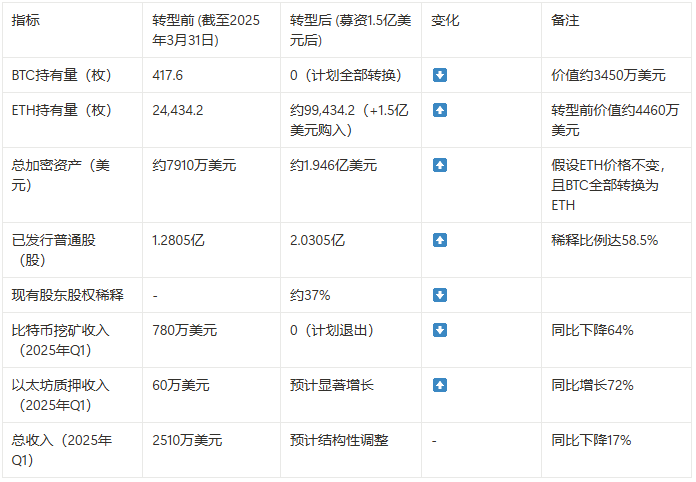
"Has the wind changed direction in the crypto world?"
In the vast world of digital assets, Nasdaq-listed Bit Digital (BTBT) announced a strategic shift in June 2025 that attracted the attention of the market: through a $150 million public offering, the company will accelerate its exit from the Bitcoin mining business and fully switch to Ethereum staking and fund operations. This huge amount of funds will be used to purchase Ethereum (ETH), making it one of the companies with the largest financial commitment to ETH in the public market to date. This move is not a simple business adjustment, but a courageous "gamble". Bit Digital will gradually sell or close its Bitcoin mining business and plans to gradually convert its Bitcoin assets into Ethereum. As of March 31, 2025, Bit Digital has held approximately 24,434 Ethereum and 418 Bitcoin, laying the foundation for its future "Ethereum purism".
This move makes people think deeply: Has the "wind direction" of the crypto world really changed? Bitcoin was once regarded as "digital gold", and its mining business was once the hottest gold mine in the digital asset field. However, with the emergence of a series of challenges and the increasing maturity of the Ethereum ecosystem, Bit Digital's shift may indicate a deep structural change in the industry.
To understand Bit Digital’s decision, we must examine the macro context of the cryptocurrency market in 2024-2025. Although the price of Bitcoin broke through the $100,000 mark in early 2025, the Bitcoin mining industry faced unprecedented structural challenges. The Bitcoin “halving” event in April 2024 directly caused miners’ block rewards to drop sharply from 6.25 BTC to 3.125 BTC. At the same time, mining difficulty continued to soar, and the hash rate rose instead of falling, reaching 831 EH/s on May 1, 2025. Transaction fee revenue fell sharply, and the hash price plummeted from $0.12 in April 2024 to about $0.049 in April 2025. High energy costs and the need for continuous equipment upgrades have squeezed the profit margins of many mining companies. Bit Digital’s Bitcoin mining revenue in the first quarter of 2025 fell 64% year-on-year to $7.8 million, and the number of Bitcoins mined fell 80% to 83.3, which is a microcosm of the industry’s predicament.
In stark contrast to the plight of Bitcoin mining, Ethereum has successfully switched from Proof of Work (PoW) to Proof of Stake (PoS) after completing “The Merge” in 2022. This shift has reduced its energy consumption by 99.95%, making it a more sustainable and environmentally friendly option, thus attracting institutional investors seeking stable returns and lower operating costs.
Bit Digital's strategic shift: a $150 million gamble
Fundraising details and Ethereum layout
Bit Digital successfully raised $150 million by issuing 75 million common shares at $2 per share. The underwriters also have a 30-day over-allotment option to purchase an additional 11.25 million shares. This fundraising has caused significant equity dilution to existing shareholders: before the issuance (as of September 2024), Bit Digital's issued share capital was 128.05 million shares. The additional 75 million shares means that the outstanding shares increased by 58.5%, and the equity of existing shareholders was diluted by nearly 37%. It is worth noting that the proceeds from this fundraising will be "exclusively used to purchase Ethereum" rather than operational growth or debt reduction. This makes the company "100% exposed to Ethereum price fluctuations" after the strategic transformation, and its financial health and stock price performance will be directly linked to the valuation of ETH. Such a large-scale equity dilution and the single purpose of funds indicate that Bit Digital's management has extremely high confidence in the future performance of Ethereum.
Bit Digital's determination to transform is also reflected in its thorough asset conversion plan. The company plans to gradually convert the 417.6 bitcoins (worth approximately $34.5 million) it holds as of March 31, 2025 into Ethereum, and sell or liquidate its global Bitcoin mining operations, including facilities in the United States, Canada, and Iceland, with the net proceeds also reinvested in ETH. This means that Bit Digital will become a "pure Ethereum staking and fund management company."
Comparison of Bit Digital's core financials and assets before and after its transformation

Say goodbye to Bitcoin mining: Why choose to "let go"?
Bit Digital's decision to bid farewell to Bitcoin mining is a rational response to the industry's deep predicament. After the Bitcoin halving in 2024, mining profitability has tightened significantly, and Bit Digital only mined 83.3 Bitcoins in the first quarter of 2025, a year-on-year decrease of 80%. The "high energy consumption" and "capital intensive" characteristics of Bitcoin mining make it unsustainable under market fluctuations and the impact of halving. Mining requires continuous investment in new hardware and faces rising operating costs, while Ethereum staking "relies on cheaper machines and lower energy consumption", which significantly reduces operating costs and environmental footprint. For example, the energy consumption of the Ethereum PoS system is 99.95% lower than that of PoW, and its energy consumption level is comparable to that of a small town rather than a country. Bit Digital's transformation is not only to cope with financial pressure, but also to conform to the macro trend of the crypto industry from "energy-consuming" PoW to "capital-efficient" PoS, aiming to achieve the dual goals of "growth and sustainability". This shift reflects the evolution of values within the crypto industry: in the past, computing power competition was the core, and now capital efficiency and environmental sustainability have become new competitive advantages.
Ethereum Staking: The “Digital Gold Rush” of the New Era?
The PoW vs. PoS debate: efficiency, profitability, and sustainability
The core of Bit Digital's strategic transformation lies in a deep understanding of the fundamental differences between Bitcoin's Proof of Work (PoW) mechanism and Ethereum's Proof of Stake (PoS) mechanism. Bitcoin's PoW mechanism is known for its strong security and decentralization, but at the cost of huge energy consumption, consuming up to 67 to 240 terawatt hours per year, and a single transaction consumes about 830 kWh of energy. This not only brings environmental problems, but also makes miners bear high electricity costs and dedicated hardware investment.
In contrast, the PoS mechanism that Ethereum turned to after the "merger" exhibits amazing energy efficiency. The PoS system eliminates the need for energy-intensive computing by having validators stake tokens to participate in network security and transaction verification. Ethereum's energy consumption is therefore reduced by 99.95%, with a single transaction consuming only 50 kWh. This efficiency improvement makes it a more sustainable blockchain solution and also greatly reduces operating costs, providing an attractive option for companies seeking stable returns and reduced expenses. The PoS mechanism provides a more attractive profit model: stakers earn passive income by contributing to network security, similar to interest on bank deposits. The annualized rate of return on Ethereum staking is typically between 4% and 7%, which can provide a more stable and predictable cash flow compared to the unpredictability of Bitcoin mining.
Liquidity Staking Derivatives (LSDs): Unlocking a New Paradigm of Liquidity
Traditional proof-of-stake (PoS) staking has an inherent disadvantage: the staked tokens usually need to be locked for a period of time, sacrificing asset liquidity. For example, running an Ethereum independent validator node requires staking at least 32 ETH, which cannot be used for other investments or transactions during the staking period.
The emergence of Liquid Staking Derivatives (LSDs) provides an elegant solution. LSDs allow users to obtain a derivative token (such as Ethereum's stETH) representing their staked assets while staking crypto assets. This derivative token can be freely traded or used as collateral in the decentralized finance (DeFi) ecosystem, thereby maintaining liquidity while earning staking rewards. This mechanism significantly improves capital efficiency and lowers the threshold for participating in staking. Ethereum's "Shapella" upgrade in April 2023 activated the ETH withdrawal function for staking, further driving a surge in demand for LSDs. LSDs solve the liquidity dilemma, improve capital efficiency, and lower the entry barriers to staking, significantly enhancing the attractiveness of the Ethereum ecosystem to institutional capital.
Institutional perspective: Can Ethereum surpass Bitcoin?
In the cryptocurrency space, the discussion about whether Ethereum can surpass Bitcoin in 2025 has been the focus. Larry Fink, CEO of BlackRock, once regarded Bitcoin as "digital gold", but also emphasized the revolutionary potential of tokenization for investment, believing that "every asset can be tokenized", which opens the door for Ethereum as a programmable platform. JPMorgan analysts believe that Bitcoin's dominance may continue in 2025, attributing it to the inflow of funds from spot Bitcoin ETFs and corporate purchase plans. MicroStrategy founder Michael Saylor is known for his firm "Bitcoin first" stance. Fidelity Digital Assets is positive about the long-term prospects of both Bitcoin and Ethereum. These views reflect different narratives of institutions on crypto assets: Bitcoin as a store of value, Ethereum as a programmable platform and the core of the innovative ecosystem.
Conclusion: Deep revelation of the “wind direction” of the crypto industry
Bit Digital's strategic shift is a microcosm of the change in the "wind direction" of the cryptocurrency industry, and a brave response to market dynamics and technological evolution. The company resolutely withdrew from the energy-intensive and profit-squeezed Bitcoin mining business, fully embraced Ethereum staking, and actively expanded high-performance computing and AI services. This is not only its own survival strategy, but also provides an important industry demonstration effect for other digital asset companies facing similar difficulties.
This case clearly reveals the trend of the crypto market from "wild growth" to "intensive cultivation". In the past, computing power competition and the narrative of "digital gold" dominated the market. Now, with the maturity of Ethereum's PoS mechanism, the industry's focus is shifting to capital efficiency, environmental sustainability and predictable returns. Financial innovations such as liquidity pledge derivatives (LSDs) have further unlocked asset liquidity, promoted the deep integration of the DeFi ecosystem and the unlimited expansion of application scenarios. This shows that the crypto industry is moving beyond the purely speculative attributes and moving towards more practical value, more refined financial engineering and broader application areas.
Looking ahead, the crypto industry will continue to focus on the resonance of efficiency, sustainability and compliance. Technological innovation will continue to reduce energy consumption, improve transaction speed and scalability. At the same time, as regulatory agencies such as the SEC gradually clarify businesses such as pledges, the confidence of institutional investors to participate will be further enhanced. Bit Digital's gamble is a concentrated manifestation of these macro forces at the micro level. Its success or failure not only affects the fate of a company, but also provides valuable experience and inspiration for the entire digital asset field on how to adapt, innovate, and achieve long-term success in the evolving market. Has the "wind direction" of the crypto world really changed? Bit Digital's actions have undoubtedly cast a heavy stone and aroused ripples, which deserves our continued attention and in-depth thinking.







